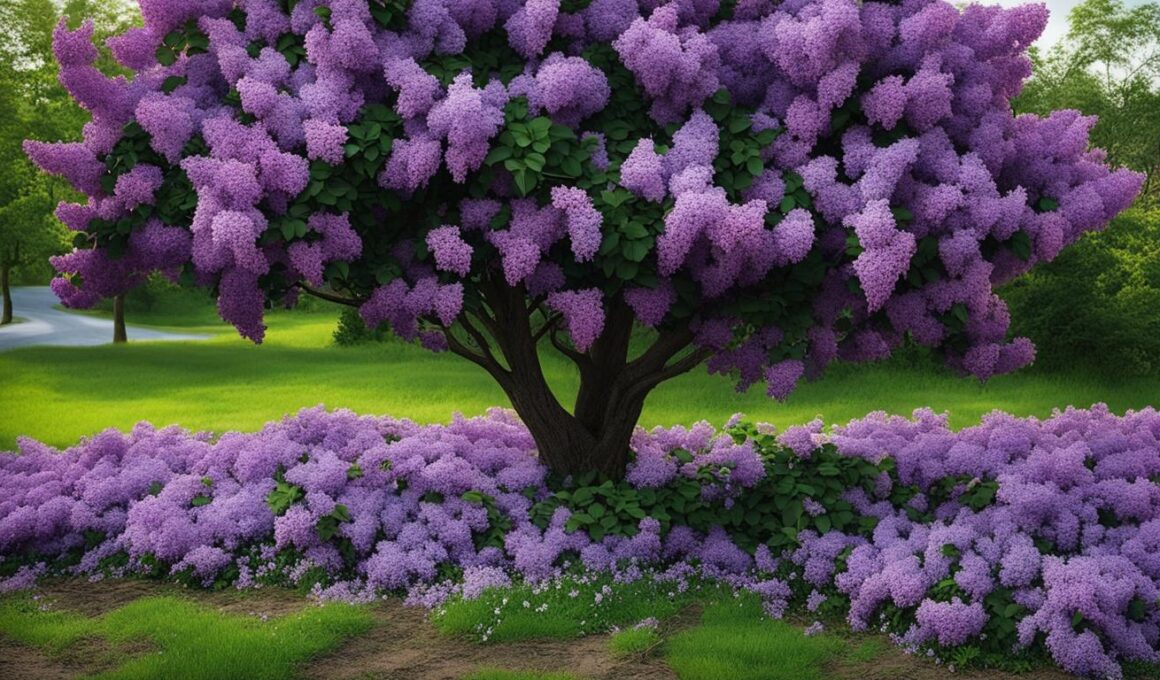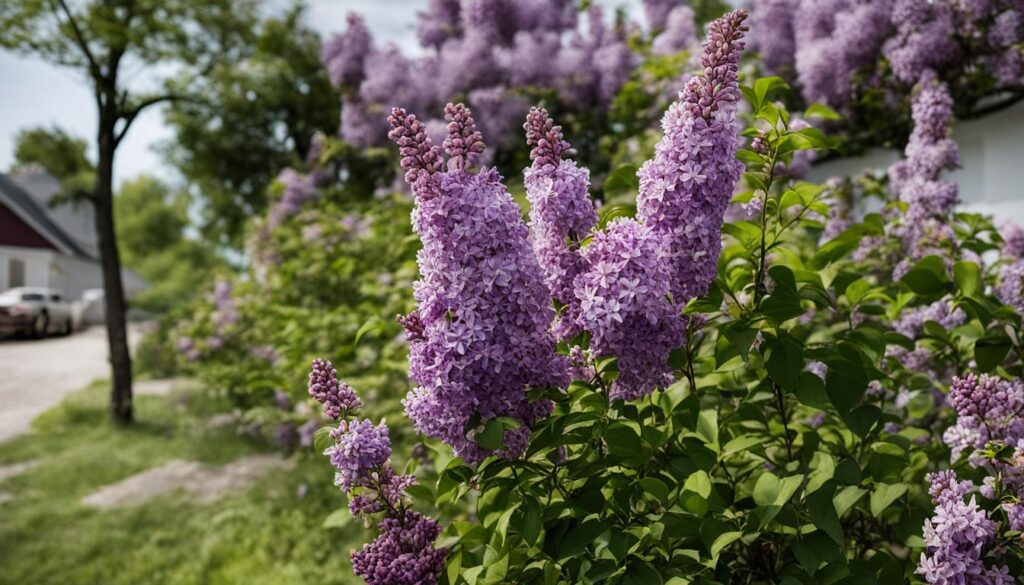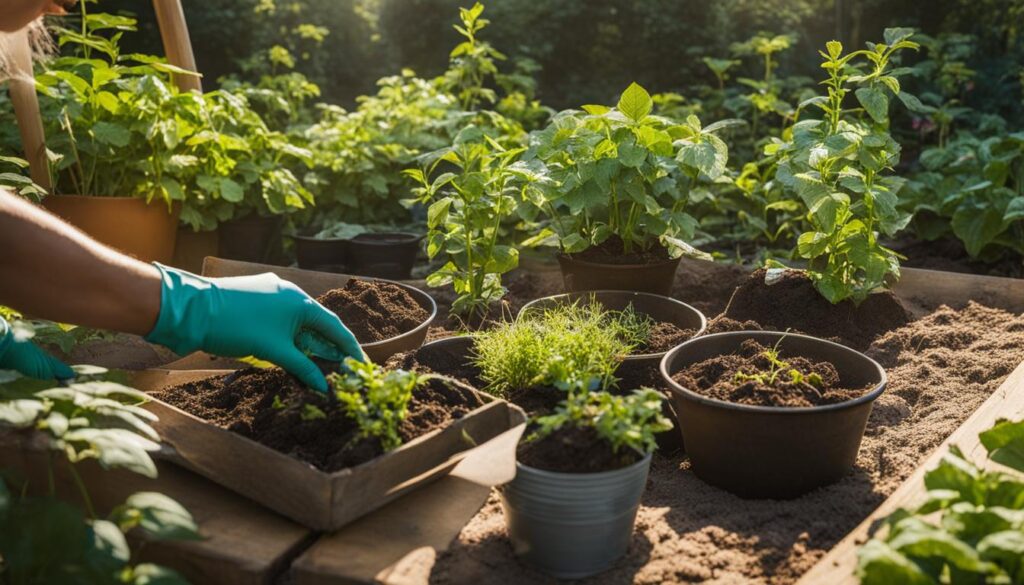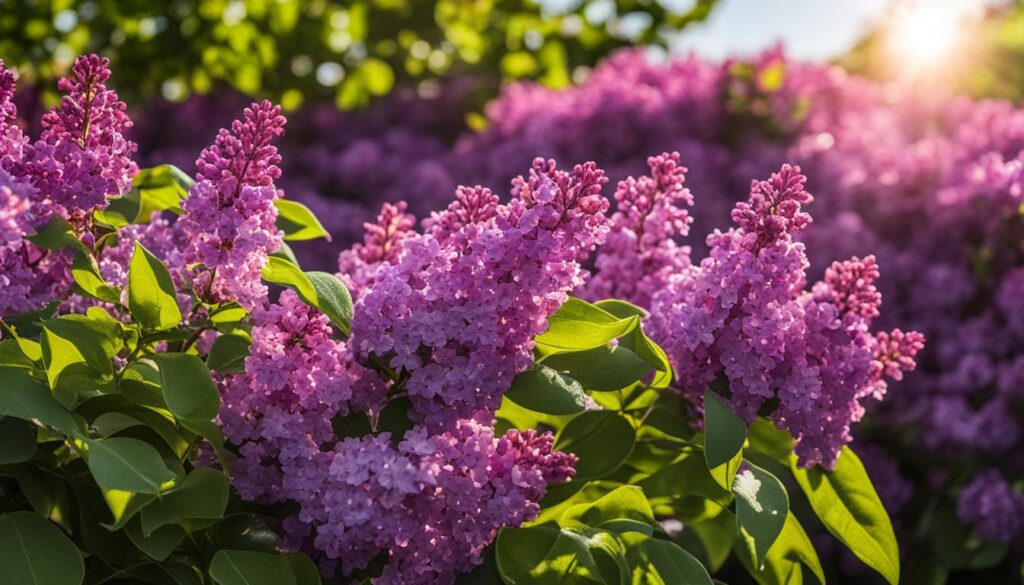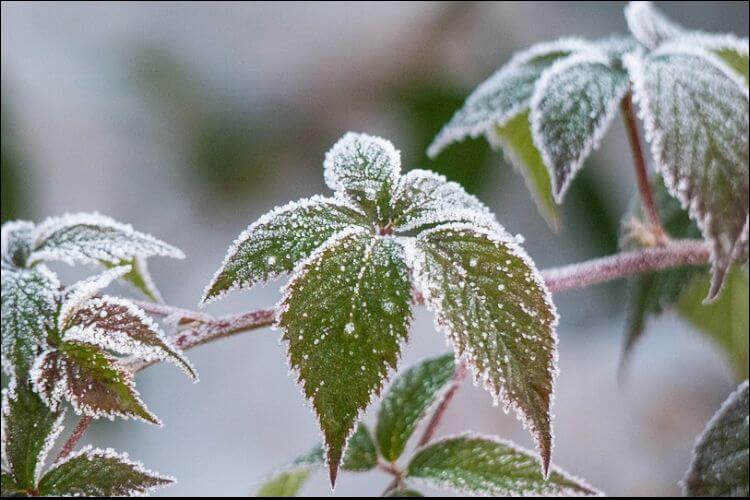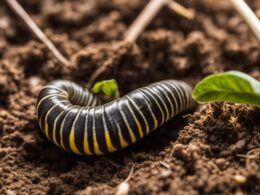Have you ever wondered if bleach is a viable option for eliminating a pesky lilac bush in your garden? In this article, we will explore the effectiveness of bleach in killing lilac bushes and provide alternative methods for safe and efficient removal.
Before you reach for that bottle of bleach, it’s important to note that bleach is not an effective herbicide for killing a lilac bush. While it may cause damage to the foliage, turning it brown and causing the leaves to drop off, bleach does not penetrate the plant’s system and effectively kill it down to the roots.
If a lilac bush has been exposed to bleach, it is recommended to spray it with water as soon as possible to wash off the chemical and protect the foliage. Now let’s delve into a deeper understanding of lilac bushes, the inefficiency of bleach, and alternative methods for removing these plants.
Post Summary
- Bleach is not effective for killing lilac bushes down to the roots.
- It is recommended to spray a lilac bush with water if it has been exposed to bleach.
- Lilac bushes are ornamental plants that can interfere with other plants and attract bees.
- Alternative methods for lilac bush removal include manual removal, herbicides, and natural pesticides.
- Pruning and disease control are important for maintaining healthy lilac bushes.
Understanding Lilac Bushes
Lilac bushes, scientifically known as Syringa spp., are beautiful ornamental plants that add charm to gardens. Their vibrant blooms, ranging in shades of purple, pink, and white, make them a popular choice among gardeners. Lilac bushes are valued for their lush foliage and enticing fragrance, making them an excellent addition to any garden or landscape.
These ornamental plants are often grown for their aesthetic appeal, with their blossoms attracting attention and admiration. The clusters of delicate flowers create a stunning visual display and release a sweet floral scent that fills the air. Lilac bushes are commonly used as focal points in garden designs, adding color and interest to the overall landscape.
While lilac bushes are beloved for their beauty, they can sometimes pose challenges in the garden. One challenge is their ability to interfere with other plants. Lilac bushes have an extensive root system that competes with nearby plants for nutrients and water. It’s important to consider the spacing and placement of lilac bushes to ensure they don’t overpower or overshadow other garden plants.
Attractiveness to Bees
Another consideration when growing lilac bushes is their attraction to bees. The fragrant blooms of lilac bushes are highly appealing to bees, which are essential pollinators for many plants. While bees play a crucial role in the ecosystem, some individuals may be concerned about the presence of bees in their garden. If you have a bee allergy or prefer to minimize bee activity around your outdoor living spaces, it’s advisable to plant lilac bushes further away from frequently used areas.
Understanding the nature of lilac bushes, including their ornamental value, competitive nature, and bee attractability, allows gardeners to make informed decisions when incorporating these plants into their landscapes. By carefully considering the placement and purpose of lilac bushes, you can create a harmonious and visually pleasing garden that balances both beauty and functionality.
The Ineffectiveness of Bleach
Bleach is not designed to target and kill plants. Its chemical makeup makes it a disinfectant and cleaning product, primarily used to remove dirt, bacteria, and organic matter from surfaces. While bleach can be used to clean around a lilac bush, it will not effectively kill the plant itself.
When it comes to plants, bleach acts as a biocide, meaning it kills various forms of life, both harmful and beneficial. However, its impact on plants is limited. Bleach may harm the foliage of a lilac bush, causing it to turn brown and drop off, but it does not penetrate the plant’s system and kill it down to the roots. The roots are the lifeline of a plant, providing it with nutrients and water, and bleach fails to reach this vital part of the lilac bush.
If a lilac bush has been exposed to bleach, it is recommended to spray it with water as soon as possible to wash off the chemical and protect the foliage. Diluting bleach with large amounts of water before applying it to a lilac bush can also help reduce any potential damage. However, it’s important to note that even with dilution, bleach is unlikely to effectively kill the plant.
| Pros of Bleach Usage on Lilac Bushes | Cons of Bleach Usage on Lilac Bushes |
|---|---|
|
|
In conclusion, while bleach is a powerful disinfectant and cleaning product, it is not an effective method for killing a lilac bush. Its primary function is to remove dirt and bacteria from surfaces, rather than targeting and eliminating plants. To safely and effectively remove a lilac bush, it is recommended to explore alternative methods such as manual removal, herbicides, or natural pesticides.
Diluting Bleach for Minimal Damage
If you find yourself needing to use bleach on a lilac bush, it is crucial to dilute it properly to minimize potential damage. By diluting bleach with large amounts of water, you can reduce the concentration of the chemicals, making it less harmful to the plant. Remember to always prioritize the safety of both the lilac bush and the surrounding plants and grass.
To dilute bleach for minimal damage to a lilac bush:
- Fill a spray bottle with water.
- Add a small amount of bleach to the spray bottle, following the recommended dilution ratio on the bleach product label.
- Shake the spray bottle gently to mix the water and bleach together.
- Test a small area of the lilac bush by spraying a fine mist on the foliage. Observe for any negative reactions such as browning or wilting.
- If there are no adverse effects, proceed to spray the diluted bleach solution on the affected areas of the lilac bush.
It is important to note that even with proper dilution, bleach can still cause harm to the lilac bush. Therefore, it is crucial to minimize contact with the surrounding plants and grass as much as possible. Preventing the bleach solution from coming into contact with other vegetation can help prevent unintentional damage and promote overall plant health.
Quotes
“Diluting bleach with water is essential when using it on a lilac bush. This helps reduce the concentration of the chemicals and minimize potential damage to the plant.”
“By following proper dilution techniques and taking precautions, you can use bleach effectively without causing excessive harm to the lilac bush or the surrounding plants.”
Diluting Bleach for Minimal Damage
| Step | Instructions |
|---|---|
| 1 | Fill a spray bottle with water. |
| 2 | Add a small amount of bleach to the spray bottle, following the recommended dilution ratio on the bleach product label. |
| 3 | Shake the spray bottle gently to mix the water and bleach together. |
| 4 | Test a small area of the lilac bush by spraying a fine mist on the foliage. Observe for any negative reactions such as browning or wilting. |
| 5 | If there are no adverse effects, proceed to spray the diluted bleach solution on the affected areas of the lilac bush. |
Alternatives to Bleach for Weed Removal
If you’re looking for alternative methods to remove weeds from your garden without resorting to bleach, there are several effective options available. These alternatives are not only safer for your plants and the environment but also provide long-term weed control. Here are some alternatives to consider:
- Manual Weed Removal: This method involves physically pulling out weeds by hand or using hand tools like a garden fork or trowel. It can be time-consuming but is highly effective, especially for smaller weed infestations.
- Natural Pesticides: Natural pesticides, such as neem oil or vinegar, can be effective in killing and preventing weed growth. These organic solutions are less harmful to the environment and can be applied directly to the weeds without causing damage to your lilac bushes or other desired plants.
- Mulching: Applying a layer of organic mulch, such as wood chips or straw, can help suppress weed growth by blocking sunlight and preventing weed seeds from germinating. It also helps retain moisture in the soil and improve the overall health of your garden.
By using these alternatives, you can effectively control and remove weeds from your garden while keeping your lilac bushes and other plants safe. It’s important to choose the method that best suits your specific needs and preferences and to follow the recommended application instructions.
Comparison of Weed Removal Methods
| Method | Effectiveness | Environmental Impact | Ease of Use |
|---|---|---|---|
| Manual Weed Removal | High | Low | Medium |
| Natural Pesticides | Medium | Low to Moderate | Medium |
| Mulching | Low to Medium | Low | Easy |
Note: Effectiveness, environmental impact, and ease of use may vary depending on factors such as weed type, garden size, and user experience. It’s important to assess your specific situation and choose the most suitable method accordingly.
By exploring these alternatives to bleach for weed removal, you can maintain a healthy garden environment while ensuring the well-being of your lilac bushes and other desired plants.
Removing Lilac Bushes
Manual Removal
If you want to remove a lilac bush from your garden, manual removal is a common and effective method. This involves physically cutting back the bush to the ground and digging up the roots. The difficulty of this process will depend on the size and age of the lilac bush. Younger and smaller bushes are generally easier to remove than older and larger ones.
When manually removing a lilac bush, it’s important to use the proper tools, such as pruners, loppers, and a shovel, to ensure a clean and efficient removal. Start by cutting the bush back to the ground, removing all branches and foliage. Next, use a shovel to dig around the base of the bush, loosening the soil and exposing the roots. Carefully lift the bush out of the ground, being sure to remove as much of the root system as possible.
It’s important to note that manual removal may not completely eliminate a lilac bush, as some roots may remain in the ground and produce new growth. Regular monitoring and follow-up removal may be necessary to completely eradicate the bush.
Herbicides
In addition to manual removal, herbicides can also be used to remove lilac bushes. These chemical treatments are designed to target and kill woody or perennial plants, such as lilac bushes. When using herbicides, it’s important to choose a product specifically formulated for lilac bush removal and follow the manufacturer’s instructions carefully.
Herbicides can be applied to the foliage of the lilac bush or to the freshly cut stump. The chemicals will then be absorbed by the plant and transported to the roots, effectively killing the bush. However, it’s important to note that herbicides may also harm surrounding plants and should be used with caution. Take care to apply the herbicide only to the target plant and avoid contact with other desirable vegetation.
| Herbicide Name | Active Ingredients | Application Method | Effectiveness |
|---|---|---|---|
| Product A | Ingredient X | Foliage Spray | High |
| Product B | Ingredient Y | Stump Treatment | Medium |
| Product C | Ingredient Z | Soil Drench | Low |
Note: The above table provides an overview of different herbicide products for lilac bush removal, their active ingredients, recommended application methods, and their effectiveness. It is important to research and choose the most suitable herbicide for your specific situation.
Effective Herbicides for Lilac Bush Removal
When it comes to removing lilac bushes from your garden, using effective herbicides can make the process much easier and more efficient. These specially formulated chemicals are designed to target and kill perennials like lilac bushes, ensuring complete removal from your landscape. Here are some highly recommended herbicides that have proven to be effective in lilac bush removal:
Effective Herbicides for Lilac Bush Removal
| Herbicide Name | Main Ingredient | Kills Roots |
|---|---|---|
| Roundup | Glyphosate | Yes |
| Ortho GroundClear | Triclopyr | Yes |
| Bonide Stump-Out | Potassium Nitrate | No |
Roundup, containing glyphosate as its main ingredient, is widely recognized as a highly effective herbicide for killing lilac bushes. It works by inhibiting the growth of the plant and ultimately killing it down to the roots. Ortho GroundClear, which contains triclopyr, is another recommended option that effectively targets and kills lilac bushes. Both herbicides should be applied according to the manufacturer’s instructions and safety precautions.
While Roundup and Ortho GroundClear are effective at killing lilac bushes, it’s important to note that Bonide Stump-Out, which contains potassium nitrate, does not kill the roots. This herbicide is better suited for preventing regrowth from stumps or cuttings and not recommended as the primary method for eliminating established lilac bushes.
Before using any herbicides, it is essential to read the product label carefully and follow the instructions for application and safety guidelines. Additionally, take necessary precautions to protect surrounding vegetation and wildlife from herbicide drift or runoff. Always wear appropriate protective gear, such as gloves and goggles, when handling and applying herbicides.
Weed Control Fabric as an Alternative
When it comes to removing unwanted lilac bushes from your garden, using weed control fabric can be a highly effective alternative. This method involves placing a plastic barrier over the area where the lilac bushes are growing, blocking sunlight and preventing seed germination. By depriving the lilac bushes of the necessary conditions for growth, you can effectively eliminate them from your garden.
Weed control fabric is especially useful in areas where lilac bushes have become invasive and are spreading rapidly. By using this method, you can prevent the lilac bushes from spreading further and taking over your garden.
However, it is important to monitor the surrounding plants when using weed control fabric. The fabric blocks not only sunlight but also water, nutrients, and heat. This can potentially harm or even kill other plants in the vicinity. Regularly check the moisture levels of the soil and provide water and nutrients as needed to ensure the health of your garden.
Using weed control fabric as an alternative to removing lilac bushes is a practical and environmentally friendly solution. It eliminates the need for harsh chemicals and extensive manual labor. Just make sure to use the fabric responsibly and take care of the surrounding plants to maintain a thriving garden.
Pruning and Disease Control for Lilac Bushes
Proper pruning and disease control are crucial for maintaining the health and vitality of your lilac bushes. By following these guidelines, you can promote better growth, prevent the spread of diseases, and ensure the longevity of your plants.
Pruning Lilac Bushes
Pruning lilac bushes is best done in early summer after flowering. This allows the plant to allocate its energy towards new growth and flower production for the following year. To prune, start by removing any dead or damaged branches, cutting them back to the base of the plant. This helps improve air circulation and reduces the risk of disease.
Next, thin out the interior branches to allow more light and air to reach the center of the plant. This encourages better growth and helps to prevent the formation of dense, tangled branches. Lastly, remove any crossing or rubbing branches to prevent injuries and improve the overall shape of the lilac bush.
Disease Control
Regular inspections of your lilac bushes are important to identify and address any potential disease issues promptly. If you notice any signs of disease, such as discolored or spotted leaves, wilting, or unusual growths, it is essential to take immediate action.
For common lilac diseases like powdery mildew or leaf spot, remove and destroy the affected leaves and branches. This helps prevent the spread of the disease to other parts of the plant. It is also recommended to apply a fungicide approved for lilac bushes as a preventive measure. Follow the instructions on the product label for the application timing and frequency.
| Common Lilac Diseases | Symptoms | Treatment |
|---|---|---|
| Powdery Mildew | White powdery spots on leaves | Remove affected leaves and branches. Apply fungicide. |
| Leaf Spot | Dark spots on leaves | Remove affected leaves and branches. Apply fungicide. |
| Lilac Blight | Brown, wilted leaves | Remove affected leaves and branches. Apply fungicide. |
Regular pruning and disease control practices will help keep your lilac bushes healthy and vibrant, ensuring they continue to beautify your garden for years to come.
Manual Weed Removal and Natural Pesticides
If you’re looking for effective ways to keep your garden free from weeds without harming your precious lilac bushes, manual weed removal and the use of natural pesticides are your best options. By prioritizing these methods, you can ensure a healthy garden ecosystem while maintaining the beauty of your lilac bushes.
Manual weed removal involves physically pulling the weeds out of the ground. This can be done by hand or with the help of tools such as a trowel or a weeding fork. It’s important to remove the entire weed, including the roots, to prevent regrowth. By regularly inspecting your garden and removing weeds as soon as they appear, you can prevent them from competing with your lilac bushes for nutrients and sunlight.
“Manual weed removal is a labor-intensive but highly effective method for controlling weeds and protecting your lilac bushes. It allows you to specifically target and eliminate weeds without causing harm to your desired plants.”
In addition to manual weed removal, natural pesticides can be used to further control weed growth in your garden. Natural pesticides are derived from botanical sources and can be an effective, environmentally friendly alternative to synthetic chemical pesticides. Ingredients such as neem oil, vinegar, and salt can be used to create homemade weed control solutions to spray on the weeds, effectively killing them without harming your lilac bushes or the surrounding environment.
| Natural Pesticide | Usage | Effectiveness | Precautions |
|---|---|---|---|
| Neem oil | Mix with water and spray onto weeds | Effective against a wide range of weeds | Avoid contact with skin and eyes |
| Vinegar | Apply directly to weeds | Effective on young, annual weeds | Avoid spraying on desired plants |
| Salt | Sprinkle directly onto weeds | Effective when used sparingly | Avoid excessive application to prevent soil damage |
The combination of manual weed removal and the use of natural pesticides provides a holistic approach to weed control in your garden. By actively maintaining a weed-free environment around your lilac bushes, you can ensure their health and longevity while minimizing the need for harsh chemicals. Remember to always follow safety instructions and use protective gear when handling any pesticides.
Summary:
When it comes to weed control in your garden, manual weed removal and natural pesticides offer effective and environmentally friendly alternatives to harsh chemicals like bleach. By consistently removing weeds by hand and utilizing natural ingredients such as neem oil, vinegar, and salt, you can keep your garden clean and healthy while protecting your precious lilac bushes. These methods not only help preserve the beauty of your garden but also contribute to a sustainable and thriving ecosystem.
Wrapping Up
When it comes to removing a lilac bush, bleach is not the solution. While bleach may harm the foliage, it does not penetrate the plant’s system and kill it down to the roots. Instead, there are alternative methods that are more effective and environmentally friendly. Let’s take a look at some of these alternatives:
- Manual removal: This method involves cutting the lilac bush back to the ground and digging up the roots. It may require some effort, but it is a reliable way to completely remove the bush.
- Herbicides: Selective herbicides designed to target woody or perennial plants can be used to slowly kill the lilac bush’s cells until it dies completely. It is important to choose a herbicide that is suitable for lilac bushes and follow the instructions for application and safety precautions.
- Natural methods: Manual weed removal and the use of natural pesticides, such as neem oil, are effective ways to keep the garden clean and healthy without harming desired plants like lilac bushes.
Remember, it is essential to research and choose the appropriate alternative based on your specific situation. Whether you opt for manual removal, herbicides, or natural methods, taking proper care and following instructions will ensure the safe and effective removal of lilac bushes without causing harm to other plants or the environment.
Example Table: Comparing Lilac Bush Removal Methods
| Method | Effectiveness | Ease of Use | Environmental Impact |
|---|---|---|---|
| Manual removal | High | Moderate | Low |
| Herbicides | High | Low | Moderate |
| Natural methods | Moderate | Moderate | Low |
This table provides an overview of the effectiveness, ease of use, and environmental impact of different lilac bush removal methods. Consider these factors when determining the best approach for your specific needs.
Conclusion
When it comes to removing a lilac bush, bleach is not the answer. While bleach may harm the foliage, it does not effectively kill the plant down to the roots. Instead, there are safer and more environmentally friendly alternatives available.
Manual removal is a recommended method for removing lilac bushes. By cutting the bush back to the ground and digging up the roots, you can effectively eliminate the plant. Additionally, specialized herbicides targeting woody or perennial plants can be used to slowly kill the lilac bush’s cells until it dies completely.
It’s important to prioritize the use of alternatives before resorting to bleach or other harsh chemicals. Manual removal and targeted herbicides are effective options that can help you successfully remove lilac bushes from your garden without causing harm to other plants or the environment.
Can Bleach Harmful to Other Types of Plants?
Bleach can be harmful to other types of plants if not used properly. It can leach into the soil and disrupt the natural balance, affecting the growth of surrounding vegetation. As an alternative, consider using vinegar as a crabgrass killer, which is a natural and effective weed control solution.
FAQ
Will bleach kill a lilac bush?
No, bleach is not an effective herbicide for killing a lilac bush. While it may harm the foliage, bleach does not penetrate the plant’s system and kill it down to the roots.
What are lilac bushes?
Lilac bushes, scientifically known as Syringa spp., are beautiful ornamental plants that add charm to gardens.
Is bleach a suitable product for killing plants?
No, bleach is not designed to target and kill plants. It is primarily used as a disinfectant and cleaning product.
How should bleach be applied to a lilac bush?
If bleach is to be applied, it should be diluted with large amounts of water to minimize potential damage to the plant.
What are alternatives to using bleach for weed removal?
Manual weed removal and natural pesticides, such as neem oil, can effectively keep the garden clean and healthy without damaging desired plants like lilac bushes.
How can lilac bushes be removed from the garden?
Lilac bushes can be removed by cutting the bush back to the ground and digging up the roots. Herbicides targeting woody or perennial plants can also be used.
What are effective herbicides for lilac bush removal?
Some herbicides are more effective than others for killing perennials like lilac bushes. It is important to choose a herbicide suitable for the specific situation and follow the instructions for application and safety precautions.
Can weed control fabric be used to remove lilac bushes?
Yes, weed control fabric can be used to block sunlight and seed germination, effectively removing lilac bushes. However, it is important to monitor surrounding plants for potential damage.
How should lilac bushes be pruned and controlled for diseases?
Pruning lilac bushes in early summer after flowering and removing diseased shoots immediately can promote better air circulation and prevent reinfection.
What are alternative methods for weed removal and pest control?
Manual weed removal and the use of natural pesticides are effective methods for keeping the garden free from pests and weeds without harming desired plants like lilac bushes.
Should bleach be used to remove lilac bushes?
No, bleach is not an effective method for removing lilac bushes. There are safer and more environmentally friendly alternatives available.





